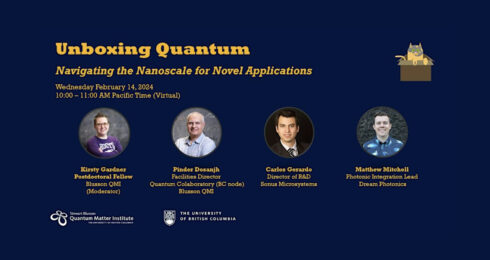A new study by Blusson QMI researchers, published in Nature Materials, reports on the discovery of superconductivity in twisted double bilayer graphene (TDBG) in proximity to an inorganic compound called tungsten diselenide (WSe2).
“The discovery of superconductivity and correlated insulator states in twisted bilayer graphene made in 2018 led to an intense international search for superconductivity across the diverse family of graphene-based structures,” said Blusson QMI Investigator Joshua Folk.
“One surprising holdout from the family of graphene superconductors has been twisted double-bilayer graphene (TDBG): Although many correlated electron phenomena observed in TDBG are analogous to those in other graphene structures, superconductivity wasn’t observed,” said Dr. Folk.
“Adding WSe2 next to graphene structures has been shown, in several cases, to strengthen superconductivity, increase the critical temperature and the range of angles over which superconductivity is observed.”
Ruiheng Su, an undergraduate student in Dr. Folk’s Quantum Devices Group and the first author of the study, led an experiment to investigate whether adding WSe2 next to TDBG would induce superconductivity in this structure as well. After a summer of making devices (over 30 of them), Su found two that were good enough to measure at a low temperature, and remarkably, he discovered superconductivity in both samples.
“This finding answers some questions and opens up other ones. It helps us to narrow down the set of electronic and crystallographic characteristics that are essential to the appearance of superconductivity in graphene,” said Dr. Folk. “At the same time, it begs the question: What is it about tungsten diselenide that is so advantageous to superconductivity in TDBG?”
The research follows previous work from the Quantum Devices Group, showing that magnetism could also be induced in TDBG. The two studies show that the material can be tuned from magnetic to superconducting states just by changing gate voltages, illustrating the enormous influence that electronic correlations have on the phenomenology of this system.
“Graphene-based superconductors are unlikely to have real-world application in the near future due to critical temperatures that are typically within a few degrees of absolute zero,” Dr. Folk said.
“However, learning about the essential ingredients of superconductivity in this otherwise-weakly-interacting material may help to engineer other systems where correlated electronic states appear over wider parameter ranges and are more easily controlled by external tuning knobs like gate voltage.”
For this study, the researchers have taken advantage of Blusson QMI’s two-dimensional (2D) material stacking facility, which enables the exfoliating and stacking of 2D materials, offering capabilities for high-yield and large-flake exfoliation of various 2D materials, automated searching for microscopic flakes, and making samples with a controlled twist between the layers.
To learn more about Blusson QMI’s capabilities in engineering exotic phases in 2D materials, please see here.
To learn more about Dr. Folk’s Quantum Devices Group, please see here.
Banner image: atomic structure of graphene, Shutterstock.
Media contact: Shahrzad (Zad) Abbasi | 604 360 6761 | shahrzad.abbasi@ubc.ca


